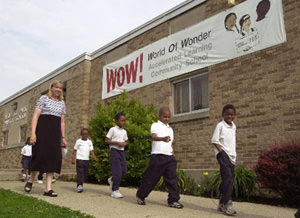Education ‘Miracles’ Don’t Survive Scrutiny
What miracle talk and magic-bullet solutions share is the reduction of complexity, of the many levels of hard, creative work necessary to make schooling successful in the United States.Miracle talk ignores the many levels of hard, creative work necessary to make schooling successful in the United States.
Despite a childhood of incantations and incense, of holy cards and stories of crutches being tossed, I don’t believe in miracles. So it is with less than wonderment that I watch as a language of miracles — along with a search for academic cure-alls and magic bullets — infuses our educational discourse and policy.
We started off the new century with the Texas Miracle, the phenomenal closing of the achievement gap and reduction of dropout rates through a program of high-stakes standardized tests. (The Texas Miracle would then spawn the federal No Child Left Behind Act.) Politicians and media-savvy administrators have also found the miraculous; the governor of my state, Arnold Schwarzenegger, referred to an Oakland charter school as an “education miracle.” And the pundits have appropriated the lingo. A recent New York Times column by David Brooks on the charter school of the Harlem Children’s Zone was titled “The Harlem Miracle.” And so it goes.
Upon closer examination, some of these miracles turn out to be suspect, the result of questionable assessments and manipulated numbers. The Texas Miracle didn’t hold up under scrutiny. And some, like the Harlem Children’s Zone — which is a commendable place — gain their excellence through hard work along multiple dimensions, from teaching and mentoring to utilizing outside resources and fundraising. There’s nothing miraculous about their successes.
Along with talk of miracles, we have the belief in educational wonder drugs and magic bullets — single-shot solutions to complicated problems: high-stakes testing, standards, charter schools, small schools, alternative teacher recruitment, slash-and-burn CEO management and so on. Each of these solutions has potential merit. Standards can bring coherence to a curriculum; small schools can result in increased student contact; alternative recruitment and credentialing bring new blood into the teaching force; some districts need the serious administrative shake-up that managerial housecleaning can provide. All good. But for these efforts to work, to increase the quality of education, other factors have to be present as well.
The structural change that leads to the small school needs to be accompanied by a robust philosophy of education, a set of beliefs about ability, learning, knowledge and the purpose of education. As well, you’ll need a decent teaching force with opportunity built in for ongoing development. And what about curriculum? Or a set of ideas on how to connect school with community? The structural move of creating the small school may be central in all this — truly important — but, at its best, it will be a necessary but not sufficient condition for educational renewal. As small-schools pioneer Deborah Meier once said, you can have crappy small schools, too.
Research on charter schools — most recently a comprehensive study from Stanford’s Center for Research on Education Outcomes — demonstrates the kind of variability you would expect if you didn’t believe in miracle cures: Some charters are terrific, some are average, and some are awful. The same set of issues I raise for small schools applies here: What you do within the new school structure matters immensely.
The kick-ass-and-take-names managerial cleanup that we’ve seen in places like Washington, D.C., and New Orleans has indeed disrupted the status quo, and I’ll leave it to those who know those districts well to judge the legitimacy of the shakeup. But what interests me is what happens once the new broom sweeps clean. Then the same weighty questions emerge, questions involving curriculum, teacher quality and development, remediation, school-community connections and the like. To address these crucial issues, the school manager will need knowledge of human development, of teaching and learning, of the wisdom of the classroom. Because few of the new CEO types possess such knowledge, you have the rush to the magic bullet.
Let me consider one more magic bullet, since recently it has been making its way through opinion pages and commentaries: alternative teacher recruitment, most notably Teach for America. (See, for example, Thomas Friedman’s April 21 New York Times column or the “NewsHour With Jim Lehrer” for July 7.)
I admire Teach for America and the public service spirit that drives its recruits. In the early ’90s, I met with founder Wendy Kopp and participated in TFA summer training in Los Angeles, and I’ve taught students who have gone into the program or came out of it. Furthermore, my own introduction to education came via an earlier alternative program, Teacher Corps. So my concern is not with Teach for America itself but with the way it has been defined as yet another wonder drug, the ingredients of which are the idealistic energy of youth and an elite education. Sadly, Teach for America has become a weapon in the education wars, rather than a laudable vehicle through which young people can contribute to the education of a nation.
I’m all for idealistic, hardworking enthusiasm, and I welcome into the nation’s classrooms these graduates of fine schools. But most of them teach for two years (and possibly a third) and then move on to the careers they went to college to pursue.
I’m troubled by two more issues related to the magic-bullet discourse here. First, many who champion TFA seem to affirm an idiosyncratic model of professional development: that these young people’s elite undergraduate educations and their energy trump extended training and experience. There is no other kind of work, from styling hair to surgery to the pro football defensive backfield, where experience is so discounted. No TFA booster, I’d wager, would choose a med student fresh out of a cardiology rotation over a cardiologist who had been in practice for 15 years. I also want to consider the assumptions about knowledge and teaching here — or more precisely the use of the status of one’s undergraduate institution as a proxy for being able to teach what one knows. Knowing history or chemistry or literature is essential to teach these subjects, but — again this is common sense — knowing something does not mean you are able to teach it, as countless undergraduates who have sat through bad lectures can verify.
Let’s consider this elite-school proxy for pedagogical expertise from one more perspective. I went through two books that profile first-rate teaching: my “Possible Lives” and Karin Chenoweth’s new “How It’s Being Done.” I also looked at the Council of Chief State School Officers’ National Teacher of the Year program. Only a handful of these top-flight teachers got their bachelor’s degrees from institutions typically defined as elite. A number hail from state universities. And a considerable number come from small local colleges with teacher education programs. Expertise in teaching is more than a function of one’s undergraduate pedigree.
What miracle talk and magic-bullet solutions share is the reduction of complexity, of the many levels of hard, creative work necessary to make schooling successful in the United States.
More so than many other domains of public policy, education is bedeviled by a binary polemics, a tendency to define an issue in either/or terms and then wage a pitched battle over the (exaggerated) differences. So we have the math wars, the whole-language versus phonics explosion, the knowledge versus process clash, and so on. These are fierce battles in which each side reduces the other’s argument — often to the point of caricature — and then assails it.
The miracle/magic-bullet discourse plays right into this state of affairs, and both emerges from and contributes to it. Part of believing in this single-shot causality requires a simplification of difficult issues and a dismissal of other possible variables and remedies. If you have the single truth, then everything else is a target.
There’s one more concern, and that has to do with failure. What happens when the miracle fades, when the magic bullet doesn’t cure the disease? For some who are ideologically inclined, there is despair, a throwing up of the hands and retreat to the dismissal of public education that we’ve witnessed over the past two or three decades.
I propose that we leave the holy cards at the schoolhouse door, that we admit that educational excellence is achieved through dedicated effort along multiple dimensions — structural, curricular and pedagogical — and that we call a moratorium on the demonizing either/or polemics that create more heat than light. Unfortunately, that moratorium would probably require a miracle — but it’s one I’m ready to pray for.
Mike Rose is on the faculty of the UCLA Graduate School of Education and Information Studies and author of a number of books, including “The Mind at Work: Valuing the Intelligence of the American Worker” and “Why School?: Reclaiming Education for All of Us,” to be published in September.
Your support matters…Independent journalism is under threat and overshadowed by heavily funded mainstream media.
You can help level the playing field. Become a member.
Your tax-deductible contribution keeps us digging beneath the headlines to give you thought-provoking, investigative reporting and analysis that unearths what's really happening- without compromise.
Give today to support our courageous, independent journalists.






You need to be a supporter to comment.
There are currently no responses to this article.
Be the first to respond.